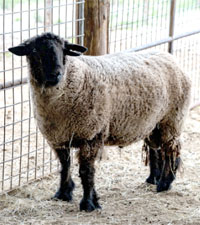
Current market conditions are in line with expected seasonal patterns, with a tighter supply leading to higher prices, said Jake Thorne, Ph.D., Texas A&M AgriLife Extension Service sheep and goat program specialist and assistant professor in the Department of Animal Science, San Angelo.
“Sheep and goats both have fairly seasonal breeding patterns, most breed in the fall and give birth in the spring, leading to a higher supply of lambs and kids in late summer,” Thorne said. “That influx often depresses prices, but this time of year, we see lower supply, which helps keep the market strong.”
Market trends and pricing
Producers with off-season breeding schedules — producing lambs and kids in the fall — are benefiting from high sale barn prices. Thorne said some premium goat prices have exceeded $4 per pound, a promising sign for producers selling high-quality animals.
In general, lamb prices above $3 per pound are considered strong, with anything over $3.50 per pound deemed excellent. Goat prices follow a similar trend, with $3.50 per pound considered strong and anything above $4 per pound highly favorable.
However, Thorne said the summertime price slump caused by higher supplies can send prices below $2 per pound.
Texas leads national production
Texas remains the nation’s top sheep and goat producer, with more goats than the next 10 states combined. The state’s goat industry is dominated by Boer and Spanish breeds, while its sheep sector features a high percentage of hair sheep such as Dorpers, which are popular in the nontraditional meat market.
“A large portion of Texas sheep and goats are shipped to metropolitan areas, particularly along the East Coast, where demand from ethnic communities remains strong,” Thorne said.
Possible headwinds for rest of 2025
Despite its production dominance, the U.S. supplies only 30-40% of domestic demand for lamb and goat meat. The remainder is imported primarily from Australia and New Zealand, which can create pricing challenges for domestic producers.
While current market conditions remain favorable, there are potential challenges ahead. Imported lamb and goat meat, often produced at a lower cost, competes with U.S. producers, limiting how high domestic prices can rise.
Other concerns include predator management, parasite control and potential disease threats. Although highly pathogenic avian influenza, HPAI, has not significantly impacted smaller ranch animals, Thorne advised producers to remain vigilant.
“Imports can undercut domestic prices, making it difficult for U.S. producers to achieve higher premiums,” Thorne said.
“There was a confirmed HPAI case in a Minnesota goat last year, but no widespread issues since,” he said. “Keeping livestock separate from poultry and monitoring for signs of illness is a good practice.”
With steady demand and Texas leading national production, the Lone Star State’s sheep and goat industry remains in a strong position, Thorne said. However, competition from imports and seasonal price shifts will be key factors to watch in the months ahead.

